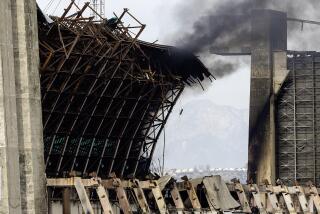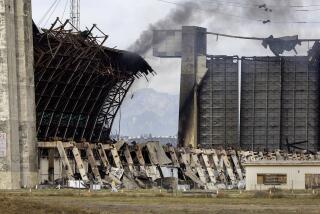Navy Declares Air Aboard Ranger Safe : Health: No sign of asbestos fibers found, officials say, but an independent expert is skeptical. The investigation continues.
- Share via
After sampling air and dust residue aboard the aircraft carrier Ranger, Navy officials said Friday that the air aboard the vessel is safe and contains no airborne asbestos fibers.
Officials have also identified about 30 people who may have been exposed to cancer-causing fibers aboard the vessel and will continue an investigation, said Capt. Charlie Robinson, safety officer with the Pacific Fleet’s Naval Air Force.
“I am confident we didn’t have any large-scale contamination on the ship--I don’t want to put my head in the sand and say nothing happened,” Robinson said. “If there was gross contamination, we couldn’t find it, but we cannot say there was not gross contamination.”
An independent asbestos expert urged that the Navy’s findings be viewed with caution. The recent samples represent “a snapshot in time,” said Dr. Arthur Frank, professor and chairman of the preventive medicine department at the University of Kentucky in Lexington. “It in no way addresses what occurred six months ago. They can’t pawn off on you that this ship is safe.”
On Aug. 17, California Marine Commercial Insulation and its president, Frank Chavez, pleaded guilty to failing to take adequate precautions during the removal of more than 260 feet of asbestos-covered pipes aboard the Ranger.
CMCI workers failed to properly wet, bag and label the asbestos as they ripped it from the ship while it was docked from last September through March. While the workers tore out the hazardous insulating material, the ship’s ventilation system was not properly sealed--a move that could have dispersed fibers throughout the vessel, according to the U.S. attorney’s office.
CMCI was not the only company to run awry of regulations aboard the Ranger. Two other civilian companies, Continental Marine Maritime of San Diego and Fryer Knowles, were cited for failing to notify the county Air Pollution Control District that they were removing asbestos, said Bob Goggin, a spokesman for the district, which launched a four-month investigation aboard the carrier after learning from the Naval Investigative Service that a CMCI employee had complained of unsafe practices. The companies were issued citations for failing to notify the district for work conducted between Aug. 25, 1989, and April 4, 1990, Goggin said.
The district also cited the Long Beach Naval Command and the supervisor of shipbuilding, conversion and repair, the Navy arm responsible for overseeing that contracts are carried out and that work is done according to regulations. The two Navy commands were cited in April for failing to notify the district that asbestos was being removed from the Ranger and for improper removal of the hazardous material, Goggin said.
The violations carry a possible $1,000 fine for failing to notify the agency of the work and $10,000 for each day that work practices were violated, Goggin said. The agency is arranging a settlement with the Navy, he said, adding that the consequences of not informing the regulatory agency of asbestos removal are serious.
“It could mean someone could have been exposed. It may happen without our finding out about it. How would we police it?” Goggin said.
Capt. Vern Edwards, commanding officer of supervisor of shipbuilding, said he would not discuss the district citations. But he said the Navy maintains a “pioneering” role in dealing with environmental issues.
“We in the Navy are probably leader in dealing with environmental issues,” Edwards said.
Concerned about the spread of asbestos fibers and the safety of sailors, Navy safety officer Robinson and a team of experts boarded the carrier last week. Three specialists sampled air in “15 to 20 different areas of the ship,” including areas where insulation was removed, such as the brig, berthing areas and passageways, Robinson said. The crew spent 16 hours combing the Ranger and checking dust residues in the recirculating-fan area.
“The air quality is no worse than the air we breathe in San Diego,” said Lt. Cmdr. Michael Williams, an industrial hygiene officer with the Pacific Fleet’s Naval Air Force.
The crew checked areas where CMCI worked and other asbestos removal had occurred during the past year, Robinson said.
Officials aboard the Ranger also required that the sailors aboard the vessel while it was at sea attend a 30-minute videotape explaining the situation. And a hot line was set up to field calls from concerned sailors, Robinson said. About 50 sailors gave statements to investigators on what they could remember of the work that occurred last winter. Another 30 expressed concern that they might have been exposed to airborne asbestos, Robinson said.
Navy officials will continue investigating these 30 cases, trying to match up each sailor’s location with areas where asbestos-removal occurred. If officials find that these individuals were exposed, the sailors will be placed in a special lifelong monitoring program offered by the Navy.
Asbestos, banned in 1979 for most construction purposes, can cause cancer and asbestosis, a fatal lung ailment. Asbestos is dangerous if inhaled into the lungs, where even one fiber can lead to death.
Part of the problem in handling asbestos cases, doctors and lawyers say, is that the disease can take from 10 to 40 years to develop. And, by the time it does, it’s often difficult to trace a patient’s exposure. Under the Navy’s monitoring program, however, a sailor is registered for his entire life. Should he develop an asbestos-related disease, doctors would easily be able to retrace its origin.
More to Read
Sign up for Essential California
The most important California stories and recommendations in your inbox every morning.
You may occasionally receive promotional content from the Los Angeles Times.













